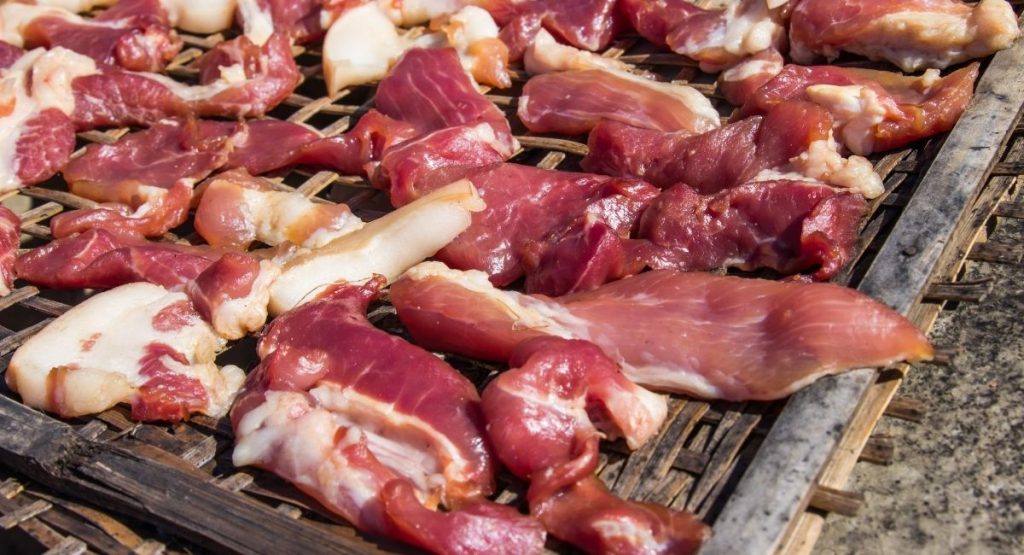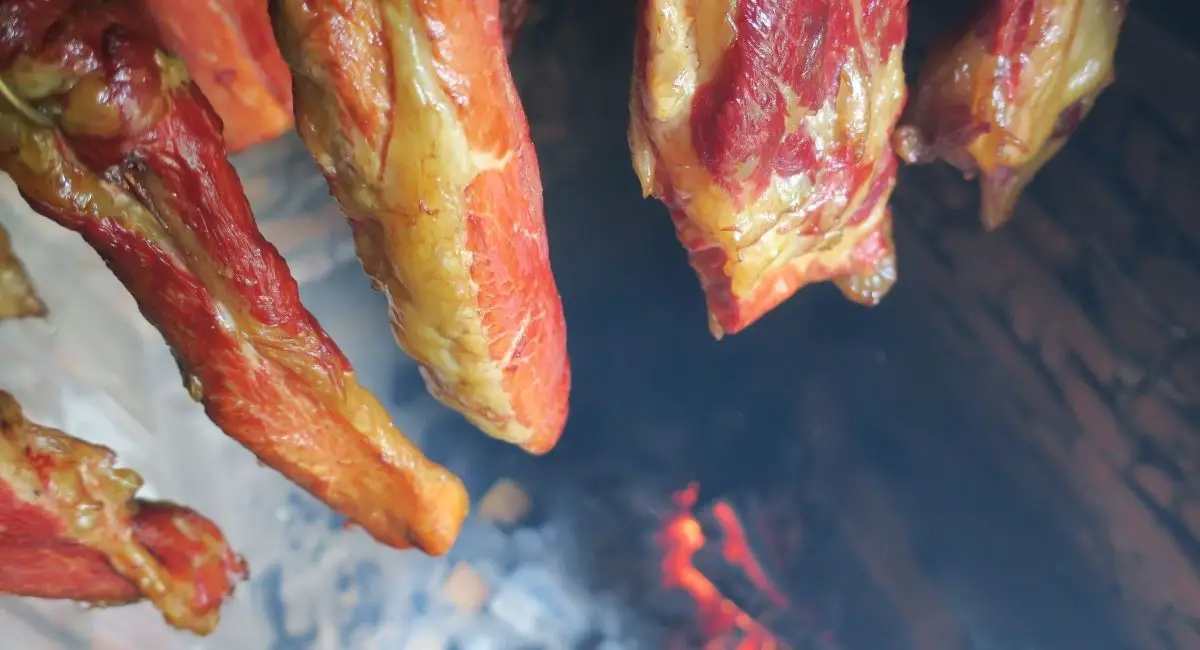Sometimes, people choose to camp to reconnect with nature and live in more simple, traditional ways. In addition to picking up a host of valuable survival skills, one thing you might need to learn for your next camping trip is how to preserve meat in the wild.
When it comes to preserving meat, the first thing that comes to mind is simply tossing the pound of meat into the freezer until you’re ready to cook it. But if you plan to go out camping, you will have to preserve meat without refrigeration.
There are many ways to extend the shelf life of raw meat. The right preservation method ensures you have flavourful meat, even after extended periods.
Read on to discover how to preserve meat for a couple of days, what goes into the process, and how to apply these techniques on your next camping adventure.
Table of Contents
- Why is it Important to Preserve Your Meat?
- Preparing Meat for Preservation
- How to Preserve Meat in the Wild
- Preservation Method 1 – Dry the Meat in Sunlight
- Preservation Method 2 – Curing
- Preservation Method 3 – Smoking
- Preservation Method 4 – Soak the Meat in Brine
- Preservation Method 5 – Adding Preservatives
- How Effective are Preservation Methods in the Wild?
- Conclusion

Why is it Important to Preserve Your Meat?
Before delving into the best ways to preserve raw meat in the wild, you should first know why this is important in the first place. Consuming meat with bacterial growth is very harmful to human health, so knowing how to preserve it properly is crucial.
After a kill, you may be left with more fresh meat than you can consume. To not let it go to waste and prevent the growth of bacteria like Clostridium Botulinum, you will have to act fast.
Growth of Bacteria in Unpreserved or Poorly Preserved Raw Meat
Like other living organisms, certain conditions facilitate the growth of bacteria more than others. For instance, meat strips left untreated at a temperature between 41ºF and 135ºF are the prime environment for bacteria growth.
Once bacteria have set in and reached infectious levels, it’s impossible to reverse, and although high temperatures can kill microorganisms, the meat will still be inedible. The spores from the bacteria remain dormant even when the meat is cooked, so by consuming such meats you put yourself at high risk of food poisoning.
To prevent the growth of bacteria, you have to control the meat’s internal temperature, moisture content, and various other aspects. In addition, you need to make sure you don’t cross-contaminate the meat as you prepare it for preservation.
The way you handle the meat and the materials you use in the preservation method can promote bacterial growth if done incorrectly.
Preparing Meat for Preservation
Even in the freeze-dried food industry, the preservation of meat is preceded by an extensive preparation process.
In many ways, the preparation of the meat is just as important as the preservation method used to increase the shelf life of the substance. This is more so the case if you want to preserve meat without refrigeration.
Because microorganisms thrive outdoors, the first thing you need to do when you get fresh meat is to bring down its internal temperature as fast as you can.
Since cold temperatures discourage bacterial growth, reducing the internal temperature of fresh meat ensures that it stays healthy and edible for you. This isn’t to say that you need to freeze the meat, you just need to cool it down long enough to get you ready for the preservation process.
Here’s how to properly prepare your meat:
- Remove the Connective Tissues
The first step in preparing your meat for preservation is to remove the connective tissues in the meat. Removing fat tissues and natural insulators reduces fat content and helps the meat cool down much faster. You can do this easily while you clean the meat.
- Cut the Meat into Smaller Pieces
After removing the connective tissues, you can cut them into smaller pieces. Doing so will dissipate heat much faster.
- Cool the Strips of Meat
After cleaning the meat, the next step is to find a way to cool the meat without refrigeration.
If you’re camping out in a colder climate region, this can work to your advantage. The cold breeze can help reduce further the internal temperature of the meat strips.
The cold weather can essentially serve as your natural refrigerator. However, if the temperature is below 41ºF, then this method of approach may no longer be ideal.
Having explained the process, read on to learn some of the best ways to increase the shelf life of your meat.
How to Preserve Meat in the Wild
There are several ways to ensure you have flavourful meat, even after extended periods in the wild. Here are five of the best methods to try out if you’re an outdoor enthusiast, which will ensure that your cuts of meat stay healthy and free of bacterial growth.
Preservation Method 1 – Dry the Meat in Sunlight
Drying meat in the sun was a common method of keeping food safe by many Native American tribes. If you want to keep things simple, then the best thing to do is dry your meat under sunlight. If your meat is already well cleaned, exposing it to natural sunlight can drastically increase its shelf life.
Dehydrated meats tend to last longer because the absence of moisture impedes the growth of bacteria. For good dehydrated meat, you need to cut the pound into strips and put them into special bags. Alternatively, you can simply cover the pieces of meat drying with a mesh net.
This process ensures that flies, insects, and other carriers of microorganisms don’t come in contact with and contaminate your food.
One of the best ways to get consistent sunlight to dehydrate your fresh meats is to hang the meat strips between trees during the day. That way, the meat will be able to dry effectively on all sides at once.
If you cannot find a good location to hang your strips, you can lay them down on a flat rock and allow one side to dry for a while. Then, you flip it over and let the other side dry as well.
When dehydrated meats are prepared properly, they can last up to two weeks without going bad. The downside is that they may not be very flavourful.
The good news is that if you’ll be moving around a lot, dehydrated meats won’t be much of a burden. Having lost a considerable amount of water during the dehydration process, these meats are usually very light to carry.
Lastly, keep in mind that the environmental condition of your camping area affects the health and longevity of dehydrated meats. For example, if it suddenly starts to rain or the climate doesn’t allow the meat to dry properly, then even consistent sunlight will not make this preservation method work as it should.
Preservation Method 2 – Curing
Also referred to as corning, this involves preserving your raw meat with salt to thoroughly dehydrate the meat.
Curing is a great way of extending the shelf life of meat because it reduces its moisture content through a process of osmosis. In a nutshell, the presence of the salt causes an electrolyte reaction that draws the inner moisture of the meat outwards.
As you know, low moisture content actively discourages the growth of bacteria.
While this is considered one of the best methods of preservation you can use in the wild, it requires that you carry a sufficient quantity of salt for the process. Without this ingredient, the curing method would not work.
You also need to keep in mind that the salt used for the curing process is not reusable. This can be discouraging for the average outdoor enthusiast because of how heavy it is to carry that much salt around.
Using this particular method to preserve meat helps facilitate the growth of good bacteria like Bacteria Lactobacillus. You can achieve this by mixing brown sugar with the salt solution or rub.
The rub also makes the fresh meat a highly inhospitable environment for organisms like Clostridium botulinum. This is the microorganism responsible for botulism.
There are two ways to carry out the curing process. You can either apply the wet curing process or the dry curing process to preserve the meat.
Wet Curing Process
This involves preparing a saline solution and applying it to the fresh meats.
The salt solution should contain no more than 14 – 20% salt in clean drinking water. To get preserved, flavourful meat, you can add a combination of spices to the saline solution as well.
To begin the wet cure process properly, put the strips of meat in the salt solution and keep it there for about 5 minutes. Then, remove the clean meat and let it dry in direct sunlight.
Once the clean drinking water mixed with salt has evaporated from the meat, you’ll be left with a thin salt layer over the meat. This layer of salt will inhibit the growth of bacteria and leave you with very flavourful strips.
Dry Curing Process
To dry-cure meat fresh from a kill, you simply need to apply salt directly to the meat rather than prepare a saline solution first. This can be perfect for you if you want to reserve your supply of clean water.
You can rub spices on the raw meat to ensure it stays flavourful, and then let the meat dry out in direct sunlight.
When your meat is finally cured, you can further preserve meat by storing it in an airtight container. While storing it, ensure that there’s a strong barrier of salt between the meats so they don’t directly touch each other and go bad.
Cured meat can last for a long time. In addition, by preserving meat in this way, you ensure that it doesn’t lose much of its flavor.
Preservation Method 3 – Smoking
When preserving meat in the wild, you need to be familiar with hot smoking. This is a great way to preserve meat for a long time without turning it into actually cooked meat.
When you smoke meat, you not only remove an ideal environment for bacteria and other harmful microorganisms, but you also make it more flavourful.
While smoked meat is delicious and lasts long, this process can be incredibly time–consuming. As such, if you’re an outdoor enthusiast who has a lot of ground to cover and you’re relatively short on time, you need to find a better way to preserve meat.
On the plus side, one of the reasons why people prefer this method is because it does not require you to carry heavy items like salts, spices, black pepper, or clean water.
Obtaining a slice of good smoked meat depends on a lot of variables, which include the following:
Availability of the Right Type of Wood
To use this effective method of preservation perfectly, you need coniferous wood. Examples of coniferous wood include cherry, oak, maple, and so on.
In the absence of such wood types, DO NOT use wood like spruce or pine to smoke meat. If you do, your meat will be unpalatable because of the bitter coat of smoke these leaves emit.
Condition of the Wood
Even when you find hardwood, you must ensure they are in the right condition to smoke meat.
To preserve meat, you need dry hardwood. If the wood is rotten or punky, then, all the better! That’s because they produce the smoke you need without moisture.
Using fresh wood is not advisable because it does not burn bright enough. Also, it will infuse your meat with fire-resistant material like carcinogens.
Presence of Canopy or Cover
This is another ancient practice of the Native American population and was their go-to method of meat preservation long before the advent of refrigeration.
To smoke meat properly, there needs to be a solid canopy over the fire. This ensures that the smoke surrounds the meat properly and permeates its layers.
Since this may not always be readily available, it’s always advisable to carry fire-resistant material in your kit to use as a suitable replacement.
Once you have these elements sorted out, you simply need to prepare the fire for the hot smoking process. Keep in mind that the smoke doesn’t exceed 109ºF to 160ºF. In addition, your meat shouldn’t be too close to the fire as you risk cooking it in the process.
You can combine the curing process with smoking to get even more flavourful meat. When combined, these methods help you preserve your cuts without the need for refrigeration.
Preservation Method 4 – Soak the Meat in Brine
Sometimes, you may not have the opportunity to dehydrate raw meat in the wild. In situations like these, the most effective method to preserve meat is to soak it in brine.
It works by submerging the pieces of meat in a salt solution, which will ensure that your raw meat is protected from the adverse effects of the atmosphere.
Because brine makes the meat an inhospitable environment for the growth of bacteria, it is one of the best methods for ensuring that your meat stays edible and safe for consumption for a long time.
Another major benefit of brining is that it keeps the meat tender and succulent. This is because it doesn’t deprive the meat of much of its moisture content, unlike other preservation methods.
To get the best results when bringing, you should use a pound of meat or larger.
You can also make your meat even more delicious by throwing in herbs, black pepper, brown sugar, and other spices into the brine.
However, the deal-breaker here is that this type of preserved meat is considerably heavy to carry around, which may make this method unsuitable for many outdoor enthusiasts. Because the meat has not been drained of its moisture content it is much heavier than dehydrated meats. Also, because the meat can only last in airtight containers, you have to add that extra weight to your travel gear.
Preservation Method 5 – Adding Preservatives
Another fast and effective method you can employ to preserve meat is to use any number of preservatives to extend the shelf life of the meat. These preservations can come as sprays or powders, so they are very easy to apply.
The main ingredient of most of these preservatives is citric acid.
The action of this substance inhibits bacterial growth and makes the surface and interior of the food safe for consumption. If you’re an outdoor enthusiast who doesn’t want to use fire to preserve fresh meat, then you can consider this method.
It is also ideal for you if you’re looking for ways to lower your sodium intake.
If you choose to add preservatives, you should know that this particular method doesn’t conserve the meat for an extended period. Since the meat doesn’t dehydrate, you would need to apply the preservatives every two or three days to ensure that the meat doesn’t lose its quality.
One way to make the effects of the preservative spray or powder last even longer is to dry the meat in direct sunlight first before applying the preservative.
In most cases, the citric acid forms a residue on the surface of the meat. You would need to scrape off this residue before you start cooking your cut.
- Pink Salt #1 - Batch Tested and Verified Gluten Free
- Perfect for wet-curing/preserving sausages, white fish, ham, salami's, all types of bacon and more!
- Enough to cure hundreds of pounds of meat
- Generally used to wet-cure meat that requires cooking before consumption
How Effective are Preservation Methods in the Wild?
Now that you have a better idea of how to preserve meat in the wild, the question is: how effective are they at extending the shelf life of your meat strips?
The answer to this depends on how well you prepared and preserved the meat. If you did those perfectly, then the preservation method you used is the final determinant of the longevity of your meat.
For example, drying your meat in direct sunlight or using citric acid preservatives alone will only keep the meat for about three days at the most. However, when you use citric acid for the preservation of meat, you have the option of reapplying it, helping you extend the shelf life beyond 3 days.
If you decide to preserve your meat through smoking or curing, these methods will help your cuts last in good condition for up to a month.
Dry curing your meat can help it last for up to three months. However, if flavor and texture are important to you, then this extended shelf life will not be beneficial to you.
Conclusion
We hope this guide has provided you with the necessary tips and techniques to preserve meat in the wild with ease. All that’s left to do is pick the preservation method that best suits the needs of the outdoor experience you have planned and you’re all set!
To learn more about life in the wild, discover new survival skills here!



